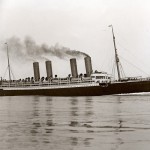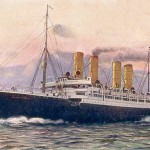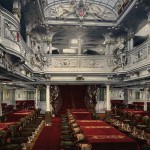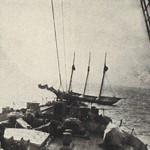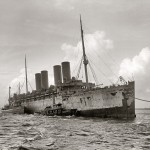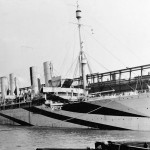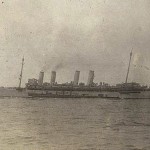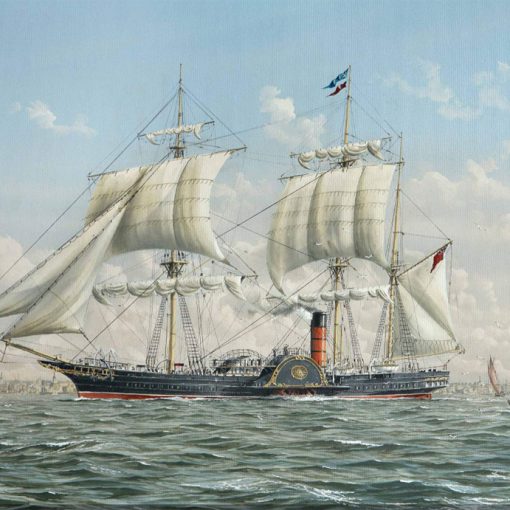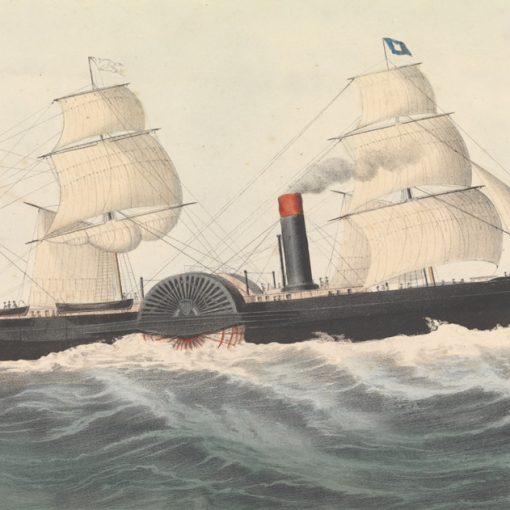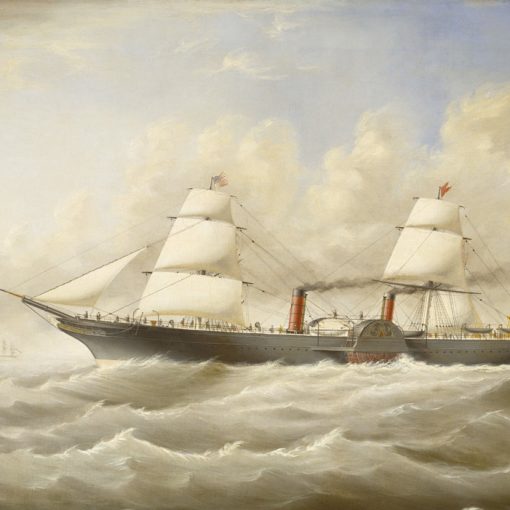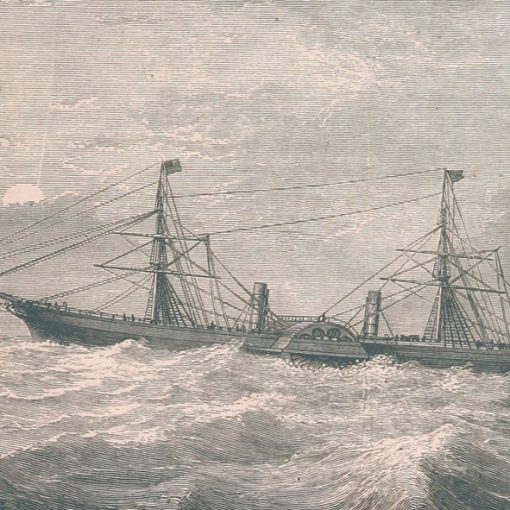1901 – 1923
In 1897, when Norddeutscher Lloyd introduced the first four-stacker – the Kaiser Wilhelm der Grosse – they had done more than establishing themselves as a top name on the North Atlantic run. The Kaiser Wilhelm der Grosse had shocked the British by easily taking the famous Blue Riband from Cunard’s speed champion Lucania. Germany had set their sights for the high seas, and they had succeeded in conquering a great deal of it.
But just as there were two great shipping companies in Great Britain – Cunard and White Star – Germany too had its two. The Hamburg-Amerika Line (HAPAG) soon set out to challenge Norddeutscher Lloyd’s pride and joy. Three years after the introduction of the Kaiser Wilhelm der Grosse, HAPAG’s new Deutschland set out on her maiden voyage in the summer of 1900. Following the trend set by Norddeutscher Lloyd, the Deutschland sported a quartet of yellow funnels. Fitted with more powerful engines, her mission was to take the Blue Riband from her rival. The mission was successful. By averaging more than 23 knots, the Deutschland soon proved to be the fastest passenger liner in the world. However, the power of her engines gave her more than great speed, they also caused the ship to vibrate when travelling under full steam. This problem was never remedied, and caused the Deutschland to be a somewhat unfavoured ship. This event made the HAPAG’s managing director, Albert Ballin, decree that his company would no longer built fast ships but large and comfortable ones. One can thereby say that HAPAG became Germany’s answer to Britain’s White Star Line, which had made the same decision a few years earlier and thereby leaving the Blue Riband for Cunard.
With that event, the Norddeutscher Lloyd became a German Cunard. They would still build fast ships, and another one was needed badly, as the Deutschland still held the Blue Riband. With that in mind, the company decided to build a sister ship to the Kaiser Wilhelm der Grosse. The same company that had built the Kaiser was chosen also for the second ship, namely the Vulkan Shipyards of Stettin.
On March 30th 1901, the new ship was christened and sent into its proper element. Following the tradition of royal names started with the Kaiser Wilhelm der Grosse, this new ship was named the Kronprinz Wilhelm after Germany’s crown prince.
When finished on August 25th 1901, the new Kronprinz Wilhelm was a ship very similar to the Kaiser Wilhelm der Grosse. As her predecessor, the Kronprinz had four funnels, characteristically grouped in two pairs. But the Kronprinz Wilhelm was a larger ship than the Kaiser, about ten feet longer and some 600 tons larger. However, she was by no means the largest ship in the world. That title was at the time held by White Star Line’s 21,035-tonner Celtic.
When it came to the interiors of the Kronprinz Wilhelm, they outmatched those on board her older sister. The same man who had decorated the Kaiser, Johannes Poppe, was chosen also for the Kronprinz and he set out to overdo himself. And so he did. When the Kaiser and the Kronprinz were later given two sisters – the Kaiser Wilhelm II and the Kronprinzessin Cecilie – Poppe decorated them too. With every new ship, there was more luxury, more ornamentation, more marble and more gilt. Norddeutscher Lloyd certainly spared no expenses to make their ships the best that Germany had to offer. To cross the Atlantic in a deluxe suite on board the Kronprinz Wilhelm in 1901 could cost as much as $2,000.
The ship’s accommodations were, like on the other liners of the time, divided into three classes. Although first class was the most luxurious one, it was the passengers in third class that really brought the company its profit. The massive European emigration provided the shipping companies with an almost unlimited flow of steerage passengers. The Kronprinz Wilhelm was designed to take on 1,761 passengers, of which 1,054 would travel in third class. Ironically, third class was given the less amount of space on board, located below decks. The accommodations here were not very comfortable and far from luxurious. Then again, it could cost as little as $10 to reach the Americas with the Kronprinz Wilhelm.
On September 17th 1901, the Kronprinz Wilhelm set out on her maiden voyage from Bremerhaven to New York. She immediately proved to be a comfortable ship, and pleased her owners in every way. Yet she lacked one important thing – speed. She had been designed to snatch the Blue Riband from the Hamburg-Amerika Line’s Deutschland, but it seemed as if the HAPAG champion’s engines could muster more power than the Kronprinz Wilhelm’s could. On one westbound crossing, the Kronprinz did in fact beat the Deutschland’s record. But the faster Deutschland soon regained the prize, and the Kronprinz could not outmatch her this time. The mission of stealing back the coveted Blue Riband had failed. Mind you however, that the Kronprinz Wilhelm was certainly no slow ship. Her service speed of 22 knots made her one of the fastest vessels operating on the North Atlantic run.
But in these early years of her career, the Kronprinz Wilhelm had some taste of bad luck when she was involved in collisions with other vessels. In 1902, in waters fifty miles east of Southampton, the German liner ran over sunk the cargo ship Robert Ingham in foggy weather, resulting in two deaths among the Robert Ingham’s crew. The Kronprinz did not sustain much damage though, and was soon back in service. But on October 8th that same year, she once again had a too near encounter with another ship, this time the 270-ton 200-feet Royal Navy Torpedo Boat Destroyer HMS Wizard. Both vessels were bound upstream in Southampton waters, when the Wizard tried to overtake the much larger Kronprinz Wilhelm. The hydrodynamic forces caused by these large hulls pulled the Wizard towards the German giant. But being the larger vessel, the Kronprinz did not suffer much from the collision. The Wizard, however, had most of her forward frames badly crushed. A similar, yet more known, incident would take place in the very same waters some nine years later, this time involving the White Star liner Olympic and the HMS Hawke.
In 1903, two years after the Kronprinz Wilhelm had entered service, a new ship joined the Norddeutscher Lloyd fleet. She was the Kaiser Wilhelm II, and a fourth sister was completed in 1906 – the Kronprinzessin Cecilie. Now the company had a long awaited four-ship express service across the North Atlantic. All four ships had a service speed of 22-23 knots, and became well known among the public because of their comfort and reliability. The quartet also became known as safe ships, and the Kronprinz Wilhelm certainly proved this when on July 8th 1907, in position 42° 50′ N – 50° 31′ W, she hit a small iceberg at a glancing blow. Fortunately, the damage sustained was minor, and she could reach port under her own power and without assistance.
But there were other dangers lurking ahead. By now, the political situation in Europe was getting tenser by the day. The rivalry between Britain and Germany, which had so far been expressed by a race on the high seas, was now making a war between the two countries a very real threat. Germany had found allies in Austria-Hungary and Italy, and Britain had joined forces with France and Russia.
Then, on June 28th 1914, the Serbian nationalist Gavrilo Princip shot and murdered the Austrian-Hungarian crown prince Franz Ferdinand. A month later, Austria-Hungary declared war on Serbia. According to the alliance between the countries, Germany then declared war on Russia, France and Belgium. This in turn led Great Britain to declare war on Germany. The First World War was now a fact.
When the message that Germany was in a state of war reached the Kronprinz Wilhelm, the ship was lying berthed at the company’s pier at Hoboken. Her commander, Captain Grahn, was given sealed orders by Germany’s ambassador in Washington. The Kronprinz Wilhelm then began taking on a great amount of supplies and coal, much more than was needed for a regular transatlantic crossing.
On August 3rd 1914, at 8.10 p.m., the Kronprinz Wilhelm left her Hoboken pier and steamed out into the North Atlantic. Her crew had been busy with covering all portholes and windows with mattresses, papers and planks to render the ship dark at night. Three days later, the Kronprinz Wilhelm met with the German cruiser Karlsruhe. Now the crew of the Kronprinz was given the word that their ship was to be transformed into a merchant cruiser. From the Karlsruhe came the man that would be the commander of the Kronprinz during the war. His name was Lieutenant Commander Thierfelder. As Captain Grahn was not a naval-commander, his ship was to be placed under the command of Commander Thierfelder, and Captain Grahn was to remain on board as first officer. The Karlsruhe also fitted the Kronprinz Wilhelm with two 88-mm. guns, which were placed on each side of the forecastle. The Kronprinzwas now ready for action.
It wasn’t until September 4th that the first prize was taken. The British steamer Indian Prince was captured and her cargo of cocoa, coffee and provisions were taken on board the Kronprinz before the enemy vessel was sunk. A few men of the Kronprinz Wilhelm’s crew were assigned to the special sinking task. They were taken on board the enemy vessel and opened its seacocks. With the water gushing in, the men hurried back to their boat and left the doomed ship before it took them down with her. Throughout the whole cruise, these men would perform this dangerous task many times.
As this was at the very beginning of World War I, the rule of chivalry was still dominant among the ships. Commander Thierfelder on board the Kronprinz Wilhelm never broke this rule, and before any ships were sunk their crew and passengers were taken on board the Kronprinz Wilhelm as prisoners of war. The passengers were given first-class accommodations and the enemy crews were placed in second class staterooms.
The Kronprinz Wilhelm had been ordered to avoid stopping in ports, so the ship was depending on capturing coal and provisions from enemy vessels. Friendly vessels also roamed the Atlantic and every time the Kronprinz met with an allied, news and supplies were exchanged. When the Kronprinz had prisoners on board, these were transferred to friendly vessels to be taken ashore.
Kronprinz Wilhelm soon became infamous. Her ability to avoid enemy vessels made it possible for her to continue as a scourge on the Atlantic for the British and their allies. From time to time it was reported in English newspapers that the Kronprinz had been sunk, but these rumours were always proven wrong eventually when she again sank a British vessel.
But as the cruise of the Kronprinz Wilhelm grew longer and longer, the ship began to suffer from the serious strain. After eight months at sea she had captured and sunken 14 ships at a combined tonnage of 58,201. But the ship was in a terrible condition, and a crack had recently been discovered in one of the ship’s propeller shafts. The crew, which had been on a diet with little or no vegetables, had began to suffer from beriberi. It was now evident to Commander Thierfelder that the Kronprinz Wilhelm’s successful raiding cruise soon would have to come to an end. Fortunately, the ship was near the United States, which had not yet entered the war. If they could enter a neutral American port, they would be safe.
On April 10th, the Kronprinz Wilhelm was just 60 miles off the Virginia Capes. Commander Thierfelder knew that in those waters there were six enemy cruisers patrolling, but he nevertheless felt confident that his ship could slip through. That night, the crew was told to make no noise and the ship was carefully inspected to make sure that other ships could see no light. Then the order ‘Full Speed Ahead’ was given. With her worn engines rattling and shaking, the Kronprinz Wilhelm shot along at more than 20 knots. With skill and some luck, she managed to avoid the patrolling cruisers and made it safely into the American waters of Chesapeake Bay. The remarkable 251-day cruise of the Kronprinz Wilhelm was over. Now she and her crew were to be interned by the US authorities.
The Kronprinz Wilhelm remained at Newport News for the next two years. But in 1917, the United States entered the war, and the ship was confiscated to be used as a troopship. She was renamed USS Von Steuben (after a German mercenary who helped bring discipline to America’s Continental Army during the American Revolution) and entered her new service in October 1917. On her first voyage as a trooper, she was involved in a collision with her sister ship Kaiser Wilhelm II, which had been renamed Agamemnon and was also being used as a US troopship. The former Kronprinz Wilhelm sustained considerable damage but managed to complete the voyage. On her return to Newport News, she underwent repairs.
In 1918, the First World War came to an end. After being decommissioned from US Naval service in October 1919, Von Steuben was handed over to the United States Shipping Board. But the ship was in a poor condition, and no one knew what to do with her. As a result she remained laid up until 1923, when she was finally sold for scrap to the Boston Metal Company. Before the year was over, the Kronprinz Wilhelm was gone.
Specifications
- 664 feet (202.8 m) long
- 66 feet (20.2 m) wide
- 14,908 gross tons
- Steam quadruple-expansion engines turning two propellers
- 22 knot service speed
- Passenger capacity of 1,761 people

